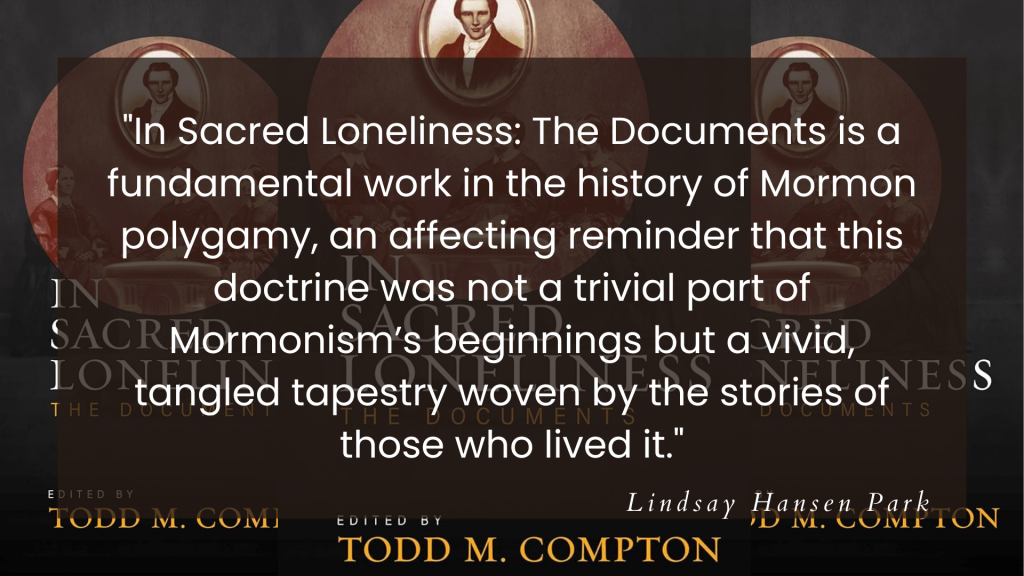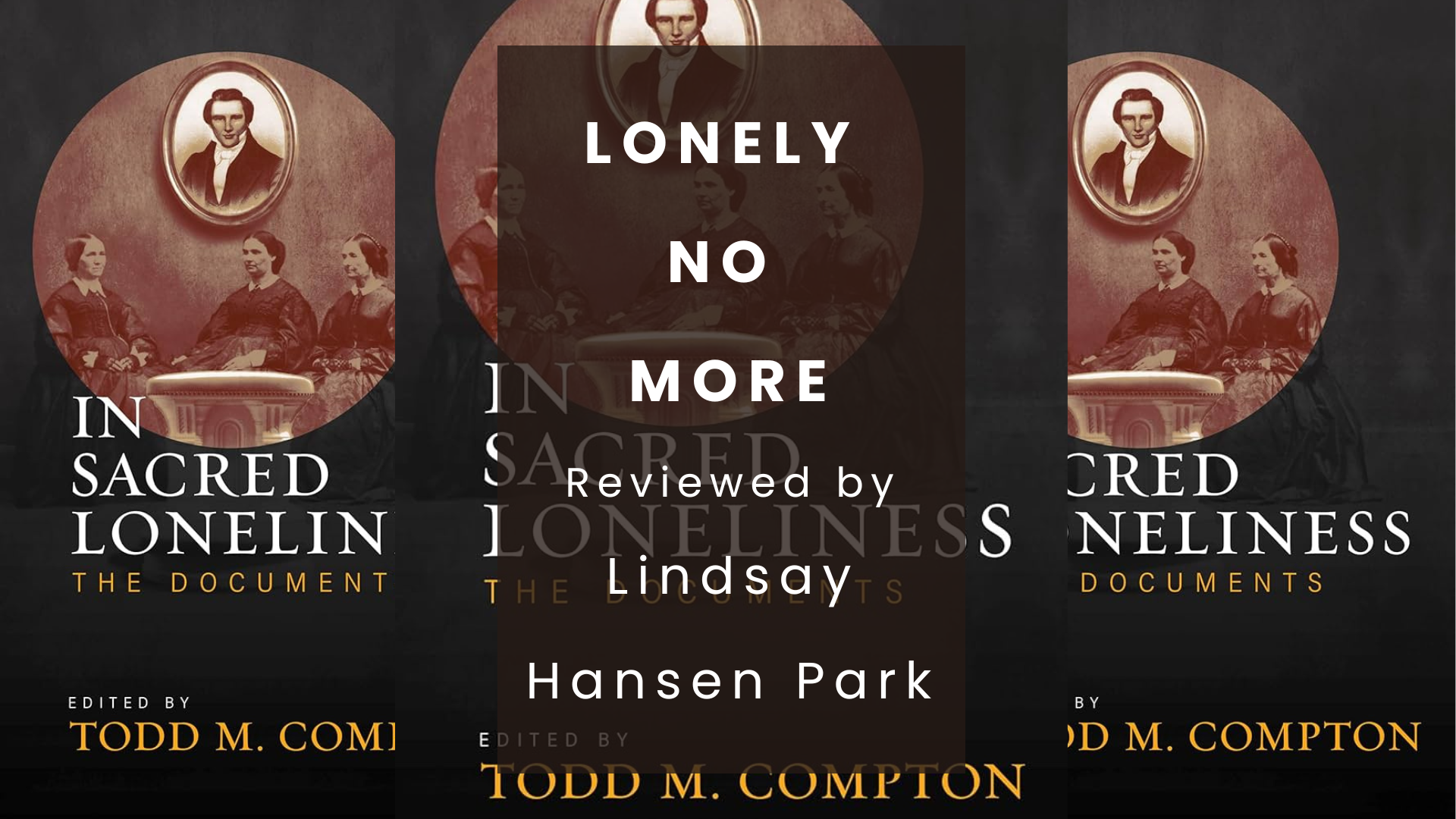Articles/Essays – Volume 57, No. 3
Lonely No More | Todd M. Compton, In Sacred Loneliness: The Documents
For Mormonism’s nearly two-century existence, few subjects have brought it more into the public spotlight than polygamy. Most writers and scholars have focused on Joseph Smith as they told this story. Until Todd Compton came along.
Todd Compton’s In Sacred Loneliness: The Plural Wives of Joseph Smith, published in 1997, focused the lens on the women involved in the practice of polygamy, centering their stories and experiences. The book is now considered the bible for anyone trying to understand this complicated, enigmatic practice.
It is no exaggeration to say that the book changed my life. Discovering it as a faithful Latter-day Saint woman and young mother living in a rural town was like finding a stick of lit dynamite. For the first time in my life, women’s voices came alive on the page to tell their stories of triumph and tragedy, love and heartbreak, faith and obedience in a way I had never before experienced. Their stories stirred an awakening in me; they detonated a path that led me to my current career.
This is why I come to you as a biased reviewer of Compton’s addendum to his original book, In Sacred Loneliness: The Documents, which he compiled and edited. This work offers new pieces to an already messy puzzle, but it’s not a sequel. It is a standalone cache of insight into Mormonism’s founding mothers. Before Compton, these women’s stories were often marginalized, silenced, or simply missing in historical narratives, but he has uncovered and amplified their voices, allowing them to emerge from the shadows.
Compton’s research is painstakingly meticulous. He draws from a wide range of sources, including personal diaries, letters, publications and firsthand accounts. The depth of his investigation is consistently impressive as he pieces together the lives of more than thirty-three of Smith’s plural wives.
In his first book, Compton complicated the polygamy narrative by dispelling the conception that Smith’s plural wives were all passive victims within a patriarchal system. With In Sacred Loneliness: The Documents, he helps us see beyond his original portraits into the long arc of these women’s lives: the details of how, over decades, they endured a painful system that too often resulted in loneliness and heartbreak.
Take, for example, the story of Emily Partridge. She became one of Smith’s secret plural wives on March 4, 1843, after the death of her father left her economically and socially vulnerable. Compton presents her story in her own words, where we see evidence of coercion and deception; she was a teenage victim of a powerful man. After the marriage, she was forbidden to tell anyone, including her mother and stepfather. Only her sister Eliza was in on the secret, since she married Smith four days later.

The story of the Partridge sisters is harrowing and sheds light on the grim realities of secret plural marriage to Mormonism’s founder. Emily later remembers the experience as “disagreeable” and “humiliating,” saying that she was too young and “inexperienced” to “count the cost before hand.” Thanks to Compton’s research, we have access to this example of Smith’s abuses of power.
In the chapter containing documents authored by Emily Partridge, Compton pulls from letters, autobiographical sketches, and journals. He tells of her life after the death of Joseph Smith in 1844, including her subsequent union with one of Smith’s successors, Brigham Young. Partridge was sealed to Young for “time,” with Young standing as proxy for Smith in an eternal sealing. Shortly after this arrangement, she gave birth to a baby boy belonging to Young on October 30, 1845, in Nauvoo. She and her new spiritual husband would go on to conceive a total of seven children.
Compton points out that despite their union, the pair were not close. “I know you cannot love me neither do I ask it for who can ^love^ what is not lovely,” Partridge wrote to Young on June 30, 1850. “I fear you will be disgusted with me for writing in plain.” By 1853 she was writing to him asking for a divorce, but she had more children with him afterward. Her many childbirths left her weak and sick, but she received little sympathy from Young. “Different ones have told me that they heard Pr. Young say, ‘Sister Emily ought to take care of herself, and he did not intend to do anything for her much longer,’” she wrote.
Her subsequent letters to Young reflect the anxiety of a woman fearing for her very survival. She was often left to beg for food or for “comforts” for her family and always feared begging too much of her husband lest she incur his wrath. In one instance, she made an appointment at his office to beg for travel money so she could see her dying mother. He accepted her into the room but “did not answer me but kept talking with others as they came in and I thought to myself it is about as I thought it would be. It will amount to nothing. I wish he would give me an answer one way or another.” Such humiliations became a constant of her life.
Compton’s book challenges simplistic narratives and invites readers to see these women as complex individuals, each with their own motivations and desires. The documents paint a deep and heartrending portrait of suffering using the words of the faithful women who lived in the culture of Mormon polygamy.
The book does more than tell the story of Mormon plural marriage; it also adds shape and texture to the early Mormon experience. In the chapter focusing on Patty Sessions, Compton provides many excerpts from the Woman’s Exponent that detail the life of Sessions and her contemporaries. Rhoda Richards’s documents give detailed insight into the practice and pitfalls of Thomsonian medicine. With Melissa Lott, we get a transcript of her 1892 Temple Lot affidavit.
While many of the women endured isolated romantic relationships, their lives were much fuller than their marriages. Their documents reveal a fuller contour of the lives of some of the West’s prominent colonizers.
In Sacred Loneliness: The Documents is a fundamental work in the history of Mormon polygamy, an affecting reminder that this doctrine was not a trivial part of Mormonism’s beginnings but a vivid, tangled tapestry woven by the stories of those who lived it. It is an invitation to consider, to empathize, and to bear witness to the sacred loneliness of these women whose voices have too often disappeared into the ethers of time.
Todd M. Compton. In Sacred Loneliness: The Documents. Salt Lake City: Signature Books, 2022. 888 pp. Hardcover: $39.95. ISBN: 978-1-56085-448-7.


 Back to full Issue
Back to full Issue

